The AMD Llano Notebook Review: Competing in the Mobile Market
by Jarred Walton & Anand Lal Shimpi on June 14, 2011 12:01 AM ESTBattery Life: All Day Computing
AMD makes a point of their mobile offerings (A/C/E-series APUs) all offering “all day computing”, with a note that “all day” is defined as eight hours or more. While that’s easy to do with a gigantic battery, doing so with the typical 48/56Wh batteries in mainstream laptops is a lot more difficult. One of their test notebooks apparently manages around 10.5 hours (best-case) with a 62Wh battery, compared to 6.5 hours for a similar Core i5-2410M laptop. Without specifics on all the settings, we’ll just say that our results for “similar” laptops don’t show nearly the disparity AMD achieved, but the important point is that AMD is finally competitive in battery life.
We ran our usual series of battery life tests, with the LCDs set for ~100 nits (70% brightness for the Llano laptop). We shut off WiFi for the idle test and mute audio; the Internet test is run over WiFi and repeatedly loads four tabs of content every minute, again with audio muted; finally, the H.264 playback result is done with a set of earbuds connected and WiFi disabled. Here’s how the Llano laptop stacks up to some recently reviewed laptops—you can compare Llano with other laptops in Mobile Bench.
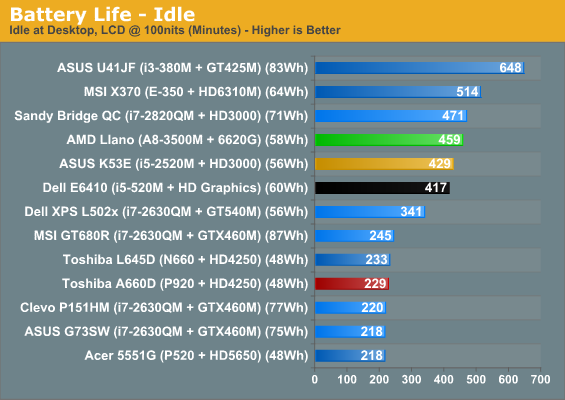

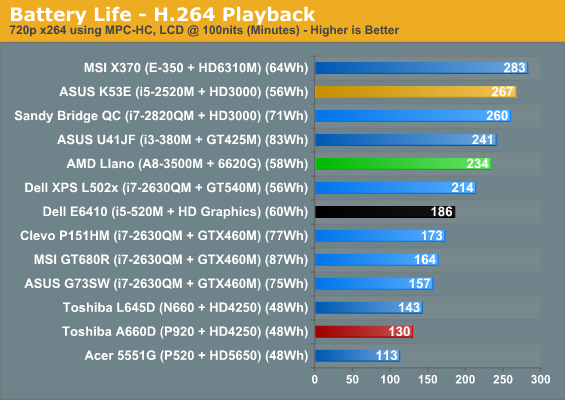
Starting with pure battery life, only three laptops consistently offer longer battery life than the Llano system: the ASUS U41JF, MSI’s X370, and the quad-core Sandy Bridge notebook. Also, the ASUS K53E boasts better battery life in the H.264 playback test, which for whatever reason is a test where SNB has proved particularly potent. Intel’s DXVA decode may be efficient, but it's also possible it's doing less work; we're running the test again with all of AMD's video enhancement features turned off. [Update: I retested with all the AMD video enhancement features disabled, and battery life didn't change, so Intel is simply more efficient at H.264 decoding with SNB.]
Back to the discussion of battery life: all three of the laptops that beat Llano have the advantage of slightly to moderately higher battery capacities, so the comparison isn’t entirely fair. Let’s level the playing field by looking at relative battery life.
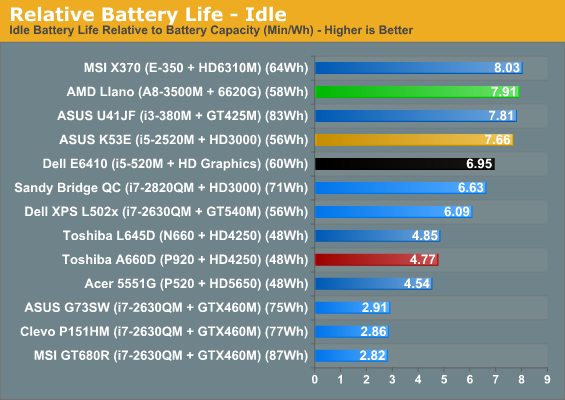
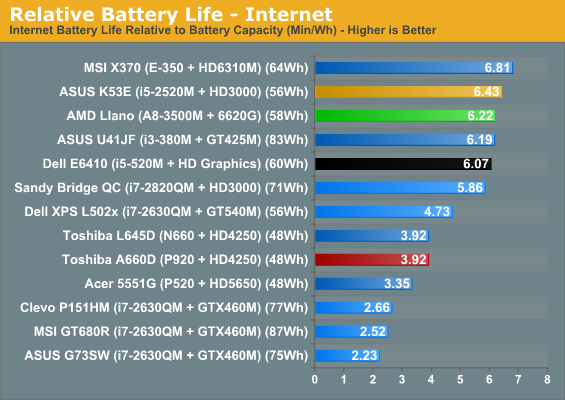
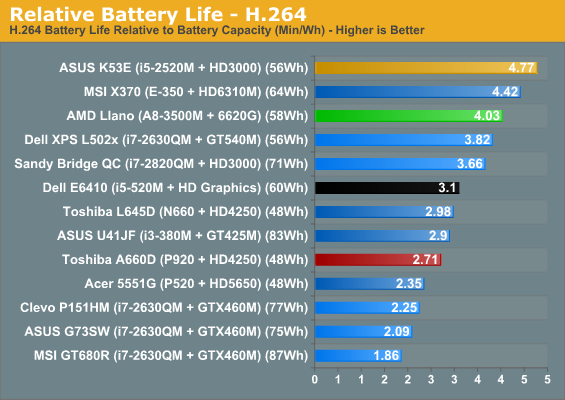
Rather amazing is that Llano actually rises to the top of the charts in the Idle test, and it’s only slightly behind the competition in the other two tests. Considering the X370 is equipped with an E-350 APU, the fact that Llano is even close is surprising. While we should note that the X370 wasn’t the most efficient of the E-350 laptops we’ve tested, we also need to point out that the 13.3” LCD is a lot closer to the 14” panel in the Llano notebook than the 11.6” panels used in the Sony YB and HP dm1z. The dual-core SNB notebook still leads in the H.264 test, and considering it has a 15.6” panel we’d say that relative battery life is very similar between the two.
We also want to talk about AMD’s claims of “all day battery life”. If we accept their definition of 8+ hours, the test laptop doesn’t actually hit that mark in our idle test. We did run the same test again at 40% LCD brightness (around 60 nits) and managed eight hours exactly, but that’s in an absolutely best-case test. For Internet surfing, which represents a more useful metric, the best way to get 8+ hours is demonstrated by ASUS’ U41JF: stuff in a higher capacity battery!
Rounding out the battery life discussion, we also tested battery life while looping 3DMark06 at native resolution (1366x768). This represents a reasonable 3D gaming scenario, and Llano still managed a reasonable 161 minutes. Considering graphics performance is a healthy step up from what Intel’s HD 3000 offers and that AMD manages double the battery life under gaming situations compared to the K53E, mobile gaming is clearly a win.
Overall, for the first time in a long time, AMD is able to offer battery life that competes with and even exceeds what Intel offers with their current mainstream offerings. There are of course a bunch of lower power Intel CPUs we could discuss, but looking at the 35W TDP parts the combination of 32nm and power gating has brought AMD back into the discussion. Even more interesting is that you should be able to get something like our test laptop for $600, possibly less, compared to dual-core SNB i5 laptops that start at $700. But then, perhaps Core i5 isn’t the best comparison for quad-core Llano, despite what AMD might like to say? Let’s move on to general performance and gaming discussions before we decide which mobile part is the “best”.










177 Comments
View All Comments
DanNeely - Tuesday, June 14, 2011 - link
Just looking at transistor count misses most of the story. The highly repetitive layout in the GPU allows for much denser transistor layout, the die is only 5% larger. That's close enough that factors like yield and raw per wafer cost become at least as important.Lunyone - Tuesday, June 14, 2011 - link
Looks like we're finally getting close to having integrated graphics good enough for some good light gaming :) Hopefully these won't be priced to high to sell. There are sooo many Sandy Bridge based laptops out there that are within the $500-600 price range it isn't even funny. I hope we can get the top of the line Llano for about $600-650. I think the C50 or E-350 have been relegated down to tablet only now, since Llano is where it's at now.ET - Tuesday, June 14, 2011 - link
Brazos will likely keep its place at the lower price point and smaller size laptops. It would be interesting to see if the larger E-350 laptops will be replaced by Llano or will survive. I was surprised they were even introduced, but it's possible that if people are buying them they will continue to do so.Still, I'm hoping that Llano can make it into small form factor laptops.
Beenthere - Tuesday, June 14, 2011 - link
I am definitely ready to buy a Llano powered laptop. I suspect Llano will suit the needs of the largest notebook segment and deliver better graphics at a lower price point. AMD is bound to take notebook market share from Intel. I wouldn't ever consider an Intel product.RussianSensation - Tuesday, June 14, 2011 - link
What? The largest notebook segment doesn't care about GPUs in a laptop. Look at Apple - a non-gaming platform more or less - and quarter after quarter has the highest growth in the notebook market share. The fact that Intel HD graphics command #1 market share in the mobile and desktop space also shows that the the majority of consumers don't care about mobile graphics beyond watching HD content.So with Llano you get a GPU that's still only fast enough for 1368x768 resolution gaming at the lowest settings and CPU performance that's only as fast as a Q6700 from 2007. Llano only makes sense if you are on a budget to buy a laptop. If you care about CPU performance, it's too slow. If you care about GPU performance, it's again too slow. So the only customer it will find is a niche one until they can create an APU with Bulldozer cores inside and a much faster GPU.
We have also seen a significant surge in consumers that desire premium made notebooks. Llano designs will likely be relegated to cheap looking and cheap quality laptops. Certainly it wont be able to compete with Ultrabooks.
I am almost certain that most of today's consumers will care about screen resolution, an SSD, the quality of the screen/materials build quality of the laptop before even thinking about the fact that Llano's GPU is faster than Intel's. Then there is AMD's past history of having unimpressive mobile CPUs over the last 5+ years. It's going to take 2-3 generations before consumers even think about switching brands in such a scenario. Most people will just buy an Intel based SB notebook simply because Intel has made the best mobile processor for the last "forever".
This is a good step for AMD, but they have a long road ahead.
duploxxx - Tuesday, June 14, 2011 - link
The share count is no longer relevant since an IGP is deployed anyhow with each system, while there are many delivered with discrete it still counts as an IGP also.Have a look at your so called apple highest growth market... it ships with discrete ATI graphics.....
Actually most don't know that the IGP is crappy, they are fooled by adiot sales and large electronic vendors who try to push there margins.
THis is the introduction generation that will shed some light, just look at the brazos also, it has been a success and even atom refresh wil not be able to take this back.
nickb64 - Tuesday, June 14, 2011 - link
arguably the most popular Apple laptop, the 13" Pro, now ships with Intel Integrated graphics, not discrete ATI/AMD graphicsOverall, you're right, but I just wanted to point out that Intel is probably getting a pretty solid boost out of 13" MBP sales this year.
jjj - Tuesday, June 14, 2011 - link
lol that's quite something to give Apple as an example for what the average user needs.Macs are niche products and will remain so without fundamental strategy changes.ps:how outraged would you be if tomorrow the new Air shows up with a Llano in it?
pps:today's average consumer makes a few hundreds $ per month and is not looking for high resolution (not that he knows wtf resolution is anyway) or SSD.
RussianSensation - Tuesday, June 14, 2011 - link
Intel wouldn't ship Air with Llano, not until they can deliver Bulldozer cores. Why would they ship a laptop with 50% slower CPU speed and go backwards? Not to mention, they'd lose Thunderbolt if they ditched SB.mino - Tuesday, June 14, 2011 - link
Thunderbolt is PCIe.